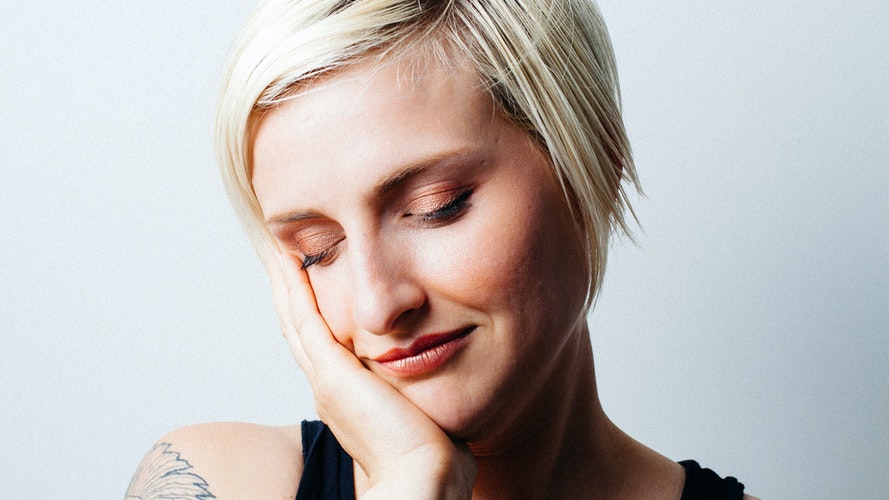Why Your Cheeks Lose Volume With Age — and How to Make Them Fuller Again
[email protected] | July 27, 23

Full cheeks are a symbol of youth — insert corny cheek-pinching joke from your grandma here — so it’s no wonder that an increasing number of men and women are seeking ways to create more fullness in this area of their face. One of the most effective ways to boost cheek volume is with temporary injectable fillers, which can instantly add natural-looking dimension. That said, you can incorporate other over-the-counter products into your regimen, as well to help with the surface of your skin. Today, we’re covering the full spectrum of options available to you, but first, let’s discuss why you may be experiencing a noticeable decrease in facial fullness.
Why Our Cheeks Lose Volume Over Time
We’re going to get straight to the point: reduced facial fullness is simply a part of getting older. “With aging, we all lose and redistribute fat padding and facial volume,” explains Dr. Gerald Imber, a plastic surgeon and the director of NYC’s Youth Corridor Clinic. “This results in a decrease in angularity and a slackness, [which are] symptomatic of the older face.” (Goodbye, full cheeks.)
In addition to these fat pads decreasing in volume, there are also some structural changes that occur in both in our skin and bones, adds Dr. Sejal Shah, a board-certified dermatologist and the founder of NYC’s SmarterSkin Dermatology.“Facial bones also lose volume, and as elastin declines, skin laxity and sagging increases,” she explains. All these things together can result in a “droopier” and more hollowed face.
In-Office Treatments for Fuller Cheeks
One of the most common in-office treatments for temporarily replenishing lost volume is injecting facial filler into and around the cheeks. The goal, obviously, isn’t to turn yourself into a cartoonish replication of a porcelain doll, but rather to strategically correct volume loss that occurred over time. Adding filler adds contour to the mid face and, can make it appear more lifted.
“Typically, [filler] is placed in the midface and mid to upper cheek. The depth of injection depends on the filler being used. Some fillers are injected just above the bone, whereas others are injected into the dermis,” says Dr. Shah. “Most people get this treatment to replace volume in the cheeks.”
On the day of the treatment, your doctor may apply a topical numbing cream prior to injecting, but this isn’t usually necessary since most fillers have anesthetic mixed into them. You may experience some pain or discomfort.
Injectable fillers do have risks like swelling, injection-site bruising, redness, or discoloration, and pain or tenderness. It’s important to talk to your doctor during the consultation about the risks as well as the benefits. Want to chat about injectables? Our trained aesthetic specialists are here to help! Get real aesthetic answers, right now from our trained aesthetic specialists!
Another in-office treatment to consider is fat grafting. This procedure is a little more involved since it requires liposuction from another area of your body beforehand. The fat is then separated from other liquids and tissue and re-injected into the face.

At-Home Options for Fuller Cheeks
If you’re seeking an alternative or a supplement to the above treatments, there are a couple at-home options you can look into, as well. First, consider adding skincare products to your regimen that help boost elasticity and firmness.
Topical retinol, also known as vitamin A, can help stimulate both elastin and collagen production, which our bodies slowly stop making once we hit our 30s. If you’re pregnant, be sure to consult your physician when considering retinol products. (Learn more about what retinol can do for your skin here.) Other ingredients to look for include ceramides which hydrate and protect the skin’s barrier, and plant stem cells, which can repair damaged cells and firm. Epidermal growth factor (EGF) is another popular choice because it’s known to improve the appearance of skin tone, firmness, and may boost collagen production. You should also always look for peptides and amino acids, which are said have all of the aforementioned benefits! Products containing hyaluronic acid and caffeine can create a temporary tightening, firming, and plumping effect, as well.
Another option to consider is facial exercises. It may sound strange, but a January 2018 pilot study of 27 women aged 40 — 65 years conducted by the Northwestern University Feinberg School of Medicine found that 30 minutes of facial exercises completed daily or bi-daily improved the overall appearance of middle-aged women, “resulting in a younger appearance with fuller upper and lower cheeks.”
“The exercises enlarge and strengthen the facial muscles, so the face becomes firmer and more toned and shaped like a younger face,” said Dr. Murad Alam, a dermatologist who lead the study. “Assuming the findings are confirmed in a larger study, individuals now have a low-cost, non-toxic way for looking younger or to augment other cosmetic or anti-aging treatments they may be seeking.”
Participants did a series of 32 different exercises, which included forming an “O” with their mouths, lifting their upper lip over their teeth, and lifting their cheek muscles up and down with their fingers. Consider it a workout for your face!
Whatever route you choose to take in your quest for fuller cheeks, a high-quality and consistent routine is key. And as always, if you opt for an in-office treatment, make sure you work with someone who’s not only credentialed, but who’s demonstrated with previous clients that they have an artful and realistic approach. Thinking about a consultation? Chat with a trained aesthetic specialist to find providers near you!






